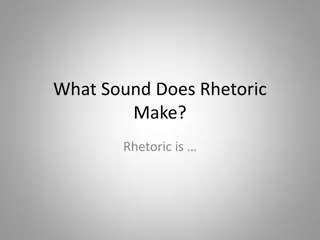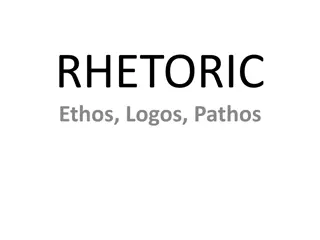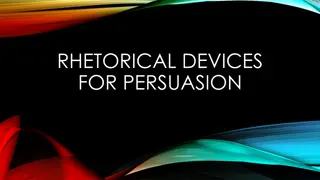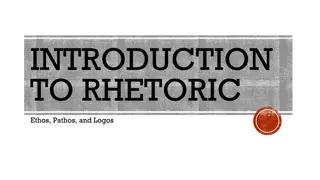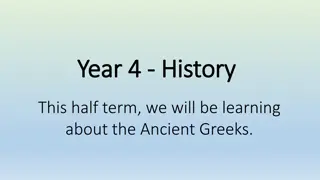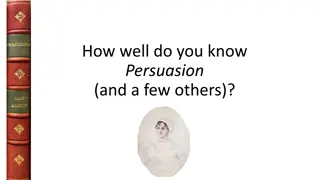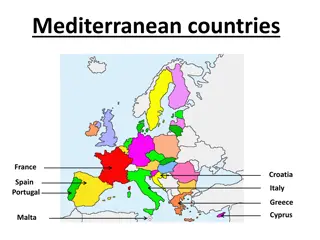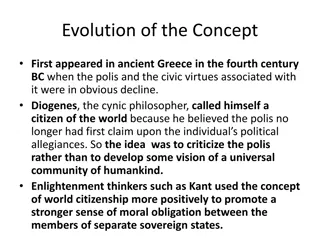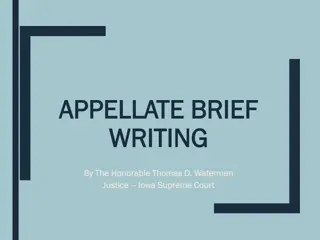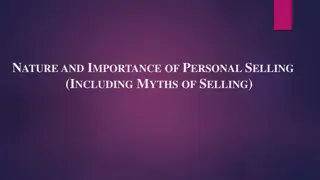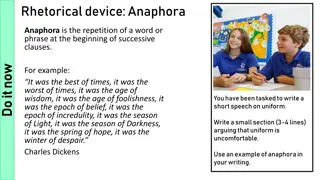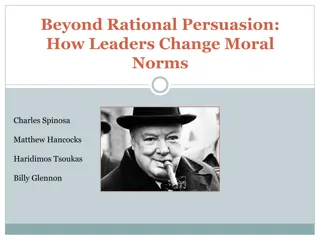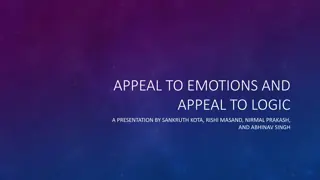The Art of Rhetoric and Persuasion: A Journey from Greece
The history of rhetoric and the concepts of persuasion trace back to ancient Greece with prominent figures like Aristotle and Plato. Aristotle's book, "The Art of Rhetoric," introduced the three methods of persuasion - Pathos, Logos, and Ethos. Pathos appeals to emotions, Logos involves logic and reasoning, while Ethos focuses on credibility and ethics. Understanding these principles and their application can enhance one's ability to effectively persuade and communicate.
Download Presentation

Please find below an Image/Link to download the presentation.
The content on the website is provided AS IS for your information and personal use only. It may not be sold, licensed, or shared on other websites without obtaining consent from the author. Download presentation by click this link. If you encounter any issues during the download, it is possible that the publisher has removed the file from their server.
E N D
Presentation Transcript
Rhetoric = The Art of Persuasion The history of rhetoric and the concepts of persuasion began in Greece.
Meet Aristotle Go to fullsize image Aristotle was a famous Greek philosopher who studied the art of persuasion. Plato, another famous Greek philosopher, was his teacher.
Translated from Greek, the word philosopher means one who loves wisdom. phil er soph philosophe r love one who wisdom philosopher
The Art of Rhetoric In approximately 300 B.C.E., Aristotle, wrote a book entitled, The Art of Rhetoric. In his book, Aristotle identified the three methods of persuasion: PATHOS, LOGOS, ETHOS Plato Aristotle
Pathos, Logos, Ethos Pathos, Logos, Ethos PATHOS = pity appeal to emotion/sex appeal/senses awwh factor appeal to memory or common experience poetic persuasion (figurative language) LOGOS = logic facts reason rationales (if then ) ETHOS = ethics ETHOS = ethics credibility/trustworthy authority/superiority in society or subject doctors, judges, celebrities
Pathos Pathos = pity (emotion) Pathos = pity (emotion) Pathos: Pathos: related to the words pathetic, sympathy, and empathy Accept a claim based on how it makes you feel without fully analyzing the rationale behind the claim May persuade you with fear, love, patriotism, guilt, hate or joy
Pathos, contd. Pathos is the use of emotional appeal.
Logos Logos = logic An if then argument Logos refers to any attempt to appeal to the intellect. The audience relies on reasoning and facts to make its decision. Numbers, polls and statistics are also examples of the Argumentative use of logic.
Ethos Ethos = Ethics Ethos = Ethics Refers to the trustworthiness of the speaker/writer. The speaker must establish moral credibility and expertise in his or her field in the minds of the audience When a judge comments on legal precedent, audiences tend to listen because it is the job of a judge to know the nature of past legal cases.
Persuasion in Advertising Review each of the following advertisements. Each one uses persuasion to sell a product or idea. Review each ad and determine which type of persuasion is being used.
#1 Pathos, logos, or ethos? Ethos, Patho s, or Logos ?
Ethos, Pathos, or Logos? Pathos, logos, or ethos? #2
#3 Pathos, logos, or ethos?
#4 Pathos, logos, or ethos? Ethos, Pathos, or Logos?
#5 Pathos, logos, or ethos?
#6 Pathos, logos, or ethos?
Ethos, Pathos, or Logos? Pathos, logos, or ethos? #7
Pathos, or Logos? #8 Pathos, logos, or ethos?
Ethos, Pathos, or Logos? Pathos, logos, or ethos? #9
#10 Pathos, Ethos, Pathos, or Logos? logos, or ethos?
Ethos, Pathos, Logos? logos, or ethos? #11 Pathos,
#12 Pathos, logos, or ethos? Ethos, Pathos, or Logos?
Using Pathos, Logos and Ethos in a Argumentative Essay In a good argumentative essay, all three types of persuasion should be employed. Begin with ethos (ethics) to provide reasons and connect with your audience. Next, employ logos (logic) and make your point with evidence and logic. Finally, end with pathos (appeal to emotions) to get your reader on your side.


